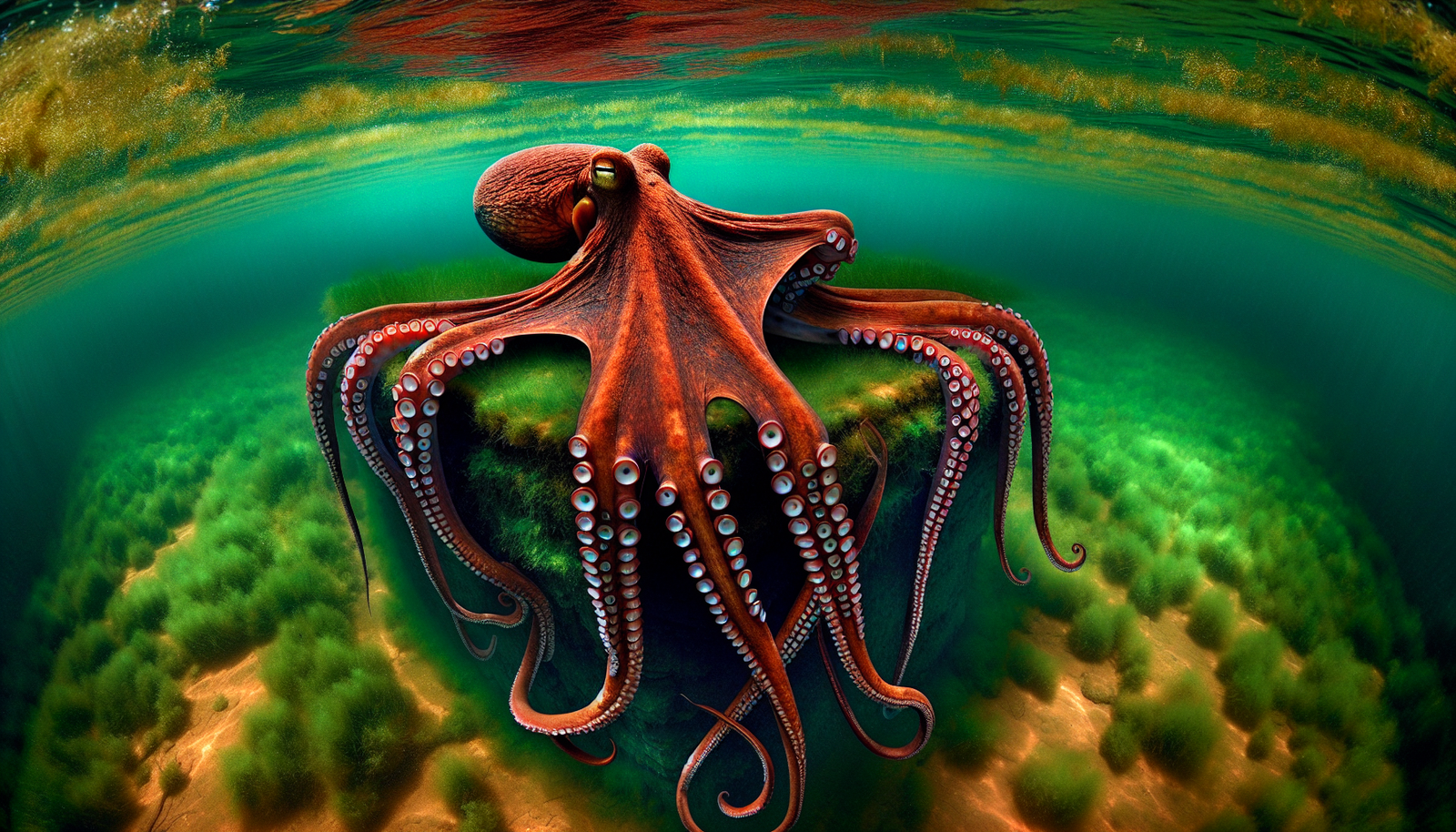The Oklahoma Octopus Legend: Myth or Reality?

By Ava Martinez, Cryptozoologist
Origins of the Legend
Every good monster story has its roots, and the Oklahoma Octopus is no exception. But unlike many cryptids with centuries-old folklore behind them, this eight-armed enigma is a relative newcomer to the world of legendary beasts.
Some proponents of the legend claim it has its origins in Native American folklore, painting a picture of ancient tribes warning their children about a tentacled terror lurking in the waters. It's a compelling narrative – after all, many cryptid stories do have ties to indigenous legends. However, when we start digging for these supposed Native American tales, we hit a snag. There's a conspicuous lack of documented evidence supporting these claims. No specific tribe is associated with the legend, and no ancient stories match the description of our freshwater friend.
So, if not from time immemorial, when did the Oklahoma Octopus first rear its slimy head? The trail leads us to much more recent history. The earliest verifiable mention of this cryptid appears to be in a 2007 book called "Monster Spotter's Guide to North America" by Scott Francis. But it wasn't until 2009 that the legend really got its tentacles into the public imagination.
The catalyst? An episode of the Animal Planet series "Lost Tapes." This show, which blended fact and fiction in a found-footage style format, featured an episode dedicated to the Oklahoma Octopus. It dramatized the tale of five high school graduates whose celebratory lake outing turns into a nightmare when they encounter the beast. Only two survive to tell the tale.
This TV portrayal, despite its fictional nature, sparked a wave of interest in the creature. Suddenly, people were sharing their own "encounters" and speculating about the possibility of a giant octopus lurking in their local lakes. The legend had found fertile ground in the age of social media and viral content.
But here's where things get really interesting. The lakes associated with the Oklahoma Octopus – Thunderbird, Tenkiller, and Oolagah – are all man-made reservoirs constructed in the mid-20th century. Lake Thunderbird, for instance, was created between 1962 and 1965. Lake Tenkiller was built between 1947 and 1952. Lake Oolagah? It didn't exist until 1974.
This timeline presents a significant challenge to the idea of an ancient, established legend. How could stories of a lake monster predate the lakes themselves? It's a bit like claiming there were urban legends about the Eiffel Tower before it was built.
The recent origin of these lakes also poses a biological conundrum. If the Oklahoma Octopus is real, how did it get there? Some proponents of the legend suggest that the creature could be a remnant from a time when the area was covered by a shallow sea, millions of years ago. While it's true that Oklahoma was once submerged, the idea of a marine animal surviving in isolation for millions of years, then adapting to freshwater in artificial lakes, stretches credibility to its breaking point.
What we're likely seeing with the Oklahoma Octopus is a perfect storm of factors coming together to create a modern myth. The construction of large, deep lakes in areas previously devoid of such bodies of water created an air of mystery. The natural human tendency to fear what lies beneath the surface of murky waters provided fertile ground for imagination. Add in a dash of media sensationalism, the virality of social media, and our enduring love for a good monster story, and you have all the ingredients for a 21st-century legend.
The evolution of the Oklahoma Octopus legend serves as a fascinating case study in how modern myths are born and propagated. It demonstrates the power of media in shaping our perceptions and the speed at which a local tale can become a widely accepted "fact" in the internet age. As we continue to explore this legend, keep in mind its recent origins – it adds an intriguing layer to our investigation of this improbable cephalopod.
Description and Characteristics
Now that we've traced the origins of our eight-armed Oklahoma resident, let's paint a picture of this alleged lake dweller. If the stories are to be believed, the Oklahoma Octopus is no ordinary cephalopod – it's a freshwater behemoth that would make even the most seasoned fisherman think twice about casting a line.
According to eyewitness accounts and local lore, the Oklahoma Octopus is a sight to behold. Imagine, if you will, an octopus the size of a horse. That's right – we're talking about a creature that could give a thoroughbred a run for its money in terms of sheer mass. Its skin is described as a reddish-brown hue, perfect for blending into the muddy waters of Oklahoma's lakes. This coloration isn't just for show – it's supposedly a key part of the creature's hunting strategy, allowing it to ambush unsuspecting prey.
But it's the tentacles that really set this beast apart. Witnesses claim they're incredibly long and powerful, capable of reaching out and snatching a full-grown adult from the safety of a boat. These appendages are said to be covered in suckers, much like their ocean-dwelling cousins, but with a grip strong enough to drag a person under in seconds.
Some accounts even suggest that the Oklahoma Octopus has developed specialized adaptations for its freshwater habitat. There are whispers of sharp claws at the ends of its tentacles, all the better for gripping slippery prey. Others claim it possesses a paralyzing venom, explaining why some victims are found without signs of struggle.
The creature's behavior, as described in various tales, is nothing short of terrifying. Unlike the typically shy and reclusive nature of most octopuses, the Oklahoma Octopus is portrayed as aggressive and territorial. It's said to actively hunt human prey, lying in wait near popular swimming areas and boat launches.
Its hunting technique, if the stories are to be believed, is the stuff of nightmares. The creature allegedly uses its camouflage abilities to blend in with the lake bottom, waiting motionlessly for an unsuspecting swimmer to venture too close. Then, in a flash of movement, it strikes. Its tentacles shoot out, wrapping around the victim and dragging them into the depths before they have a chance to cry out for help.
But it's not just swimmers who need to be wary. Boaters have reported feeling something massive bump against their vessels, accompanied by the eerie sensation of tentacles exploring the hull. Some claim to have seen giant suckers pressed against their boat windows, as if the creature were peering in at them.
The Oklahoma Octopus is also credited with unusual intelligence, even for an octopus. There are tales of it learning to avoid certain areas after increased human activity, only to appear in new locations where it's least expected. This has led to a cat-and-mouse game between the creature and those trying to prove its existence, with the octopus always seeming to be one step ahead.
Its diet, according to the legend, is varied and voracious. While human victims are the most sensational part of the story, the Oklahoma Octopus is said to feed on everything from fish and waterfowl to small mammals that venture too close to the water's edge. Some even claim it can survive on land for short periods, using its tentacles to pull itself along in search of prey.
One particularly chilling aspect of the legend is the creature's alleged longevity. Given that the lakes it inhabits are all man-made and relatively young, some versions of the story suggest that there's only one Oklahoma Octopus – an ancient, ever-growing monster that has adapted to each new lake as they were created.
Of course, it's important to remember that these descriptions come from a mix of alleged eyewitness accounts, local folklore, and good old-fashioned storytelling. The line between fact and fiction is blurry at best. But that's part of what makes the Oklahoma Octopus so fascinating – it's a creature that exists in the realm of possibility, just plausible enough to make you think twice before dipping your toes in the water.
Sightings and Anecdotes
No cryptid worth its salt exists without a healthy dose of eyewitness accounts and close encounters. The Oklahoma Octopus, despite its relatively recent entry into the pantheon of mysterious beasts, has accumulated its fair share of sightings and stories. These tales range from the mildly unsettling to the downright terrifying, each adding a new layer to the legend.
One of the most common types of encounters involves swimmers feeling something brush against their legs. Sarah Thompson, a regular at Lake Thunderbird, recounts her experience: "I was swimming near the shore when I felt something wrap around my ankle. It wasn't like seaweed or a fish – it felt strong, almost purposeful. I kicked free and swam to shore as fast as I could. When I got out, I had these weird, circular marks on my leg. They looked just like suction cup prints."
Sarah's story is far from unique. Numerous swimmers have reported similar experiences, often accompanied by unexplained bruises or marks on their bodies. These incidents have fueled speculation about the creature's hunting behavior, with some theorizing that the octopus "tastes" potential prey before deciding whether to pull them under.
Boaters, too, have their share of Oklahoma Octopus stories. John Martinez, a fishing enthusiast, shares a chilling tale from Lake Tenkiller: "I was out on my boat, just as the sun was setting. Suddenly, the whole boat shook, like something big had bumped into it. I looked over the side and saw this huge, dark shape moving under the water. Then I saw it – a tentacle, as thick as my arm, reaching up out of the water towards the boat. I've never started my engine so fast in my life."
While most encounters end with the witness escaping unscathed, there are darker stories circulating as well. These often involve unexplained drownings or disappearances. Local folklore attributes many of these tragic events to the Oklahoma Octopus, though it's important to note that there's no concrete evidence linking any actual drownings to a giant cephalopod.
One of the most intriguing incidents often cited by believers occurred not in Oklahoma, but in neighboring Arkansas. In 2003, a fisherman named John Mazurek made headlines when he caught a small octopus in Lake Conway. This real-life incident sent shockwaves through the cryptozoology community. Could this be proof that octopuses could survive in freshwater?
Upon closer examination, experts concluded that the Lake Conway octopus was likely a pet that had been recently released into the lake. Octopuses are saltwater creatures and can't survive long in freshwater environments. However, this incident demonstrates how easily a real event can fuel and shape an existing legend.
The psychological impact of these sightings and stories can't be overstated. Even for those who doubt the existence of the Oklahoma Octopus, the tales have a way of lingering in the back of one's mind. Lisa Chen, a psychologist specializing in the impact of urban legends, explains: "These stories tap into our primal fears of the unknown, especially what might be lurking beneath the surface of murky waters. Even if we rationally know the creature probably doesn't exist, the 'what if' can be a powerful force."
This psychological effect is amplified by the nature of the encounters. Many sightings occur in low-light conditions or in murky water, where the human mind is prone to filling in gaps with its worst fears. A floating log or a large catfish can easily become a tentacled monster in the right circumstances.
The role of anecdotal evidence in perpetuating the myth is crucial. While none of these stories provide concrete proof of the Oklahoma Octopus's existence, they create a rich tapestry of lore that keeps the legend alive. Each new story adds to the collective narrative, making the creature seem more real with every retelling.
It's also worth noting how these sightings have evolved over time. Early accounts were often vague, describing little more than a large, dark shape in the water. As the legend has grown and been shaped by media portrayals, the descriptions have become more detailed and specific, often aligning closely with the popular image of the creature.
This evolution of sightings is a common phenomenon in cryptozoology. As a legend takes shape, witnesses tend to report details that conform to the established narrative, whether consciously or unconsciously. This doesn't necessarily mean they're being dishonest – our brains are remarkably good at filling in gaps in our perception with what we expect to see.
While these sightings and anecdotes are compelling, they fall short of providing conclusive evidence for the existence of the Oklahoma Octopus. What they do provide, however, is a fascinating glimpse into the power of storytelling and the human tendency to seek explanations for the unexplained. Whether born of misidentification, imagination, or something more mysterious, these tales continue to captivate and terrify those who hear them.
Scientific Skepticism
While tales of the Oklahoma Octopus continue to captivate imaginations, the scientific community has a decidedly different take on the legend. Experts from various fields have weighed in on the plausibility of a giant freshwater octopus lurking in Oklahoma's lakes, and their conclusions are, to put it mildly, skeptical.
The first and most glaring issue is the fundamental biology of octopuses. Dr. Elena Rodriguez, a marine biologist specializing in cephalopods, explains: "Octopuses are, without exception, marine animals. Their physiology is adapted for life in saltwater, and they lack the necessary adaptations to survive in freshwater for any significant period."
The key issue here is osmoregulation – the process by which organisms maintain the proper concentration of salt and other solutes in their bodies. Saltwater and freshwater animals have very different osmoregulatory needs. Dr. Rodriguez continues, "If you put a marine octopus in freshwater, it would experience severe osmotic stress. Essentially, the freshwater would rush into its cells, causing them to swell and eventually burst. It's a bit like what happens if you leave a gummy bear in water overnight – it swells up and loses its shape."
This biological reality poses a significant challenge to the Oklahoma Octopus legend. For such a creature to exist, it would need to have evolved a completely new osmoregulatory system – a process that would typically take millions of years, not the mere decades since these lakes were created.
Another issue is the lack of a viable food chain to support a large predator. Dr. James Thompson, an ecologist who has studied Oklahoma's lake ecosystems, points out: "These lakes simply don't have the biomass to support a predator of the size described in the legend. A horse-sized octopus would require a massive amount of food, and we'd see significant disruptions in the local ecosystem if such a creature existed."
The absence of physical evidence is another major stumbling block for believers. Despite numerous claimed sightings, there has never been a confirmed photograph, video, or specimen of the Oklahoma Octopus. In an age where nearly everyone carries a high-quality camera in their pocket, this lack of evidence is particularly telling.
Dr. Sarah Winters, a cryptozoologist who approaches such legends with a scientific mindset, adds another perspective: "While it's true that new species are discovered regularly, they're typically small creatures in remote, unexplored areas. The idea of a large, predatory animal going undetected in heavily trafficked recreational lakes is highly improbable."
So, if not a giant octopus, what might explain the sightings and encounters people report? Experts have several theories.
Misidentification is a common explanation. Large catfish, which are abundant in Oklahoma's lakes, can grow to impressive sizes and are known to bump into boats and swimmers. In murky water or low-light conditions, it's easy to see how a brief encounter with one of these fish could be misinterpreted as something more exotic.
Dr. Thompson suggests another possibility: "Submerged logs or debris can often move in currents in ways that might seem animate to an unsuspecting observer. Combine this with the power of suggestion and the human tendency to see patterns where none exist, and you have a recipe for monster sightings."
The psychological aspect of these encounters shouldn't be underestimated either. Dr. Lisa Chen, whom we heard from earlier, explains: "When people are primed to expect something unusual, their brains are more likely to interpret ambiguous stimuli in line with those expectations. It's a well-documented phenomenon in psychology."
As for the drownings often attributed to the Oklahoma Octopus, there are unfortunately more mundane explanations. Alcohol consumption, inexperienced swimmers, and underestimating the power of currents are common factors in many drowning incidents. While these explanations may lack the drama of a cryptid attack, they highlight the very real dangers present in any body of water.
It's worth noting that the scientific community's skepticism doesn't stem from a lack of imagination or an unwillingness to consider new possibilities. Rather, it's rooted in a commitment to evidence-based conclusions. Dr. Winters puts it succinctly: "In science, extraordinary claims require extraordinary evidence. While we always remain open to new discoveries, we can't accept the existence of something that defies known biological principles without solid, verifiable proof."
This scientific perspective serves as a crucial counterbalance to the more fanciful aspects of the Oklahoma Octopus legend. It reminds us of the importance of critical thinking and the need to examine extraordinary claims with a discerning eye.
However, even the most ardent skeptics acknowledge the value of legends like the Oklahoma Octopus in sparking interest in the natural world. Dr. Rodriguez notes, "While we can say with near certainty that there's no giant octopus in Oklahoma's lakes, these stories often lead people to learn more about real aquatic life. If the legend of the Oklahoma Octopus inspires someone to become a marine biologist or conservationist, then it has served a positive purpose."
The Role of Media and Urban Legends
The tale of the Oklahoma Octopus isn't just a story about a mythical creature; it's a fascinating case study in how modern media and the mechanics of urban legends can shape and propagate a myth. In many ways, the Oklahoma Octopus is as much a creation of our information age as it is a product of folklore.
The pivotal moment in the octopus's rise to cryptid stardom came in 2009 with the airing of an episode of Animal Planet's "Lost Tapes." This show, which blended fact and fiction in a found-footage style format, featured an episode dedicated to the Oklahoma Octopus. Despite being clearly labeled as a dramatization, the impact of this episode on the legend cannot be overstated.
Media scholar Dr. Amanda Chen explains the phenomenon: "Shows like 'Lost Tapes' operate in a grey area between entertainment and information. Even when viewers know it's fiction, the realistic presentation style can leave a lasting impression. It plants a seed of 'what if' in the viewer's mind."
This "what if" factor is crucial in understanding how the legend spread so rapidly after the show aired. Social media platforms became buzzing hubs of Oklahoma Octopus discussion. People shared the story, added their own embellishments, and in some cases, even came forward with their own "encounters" that suspiciously mirrored the events portrayed in the show.
The power of visual media in shaping our perception of cryptids can't be overstated. Dr. Chen continues, "Once people have seen a visual representation of a creature, even in a fictional context, it becomes much easier for them to 'see' that creature in ambiguous real-world situations. It's a form of priming that can influence how people interpret their experiences."
This influence extends beyond just television. The internet has played a crucial role in the spread and evolution of the Oklahoma Octopus legend. Websites dedicated to cryptozoology have given the tale a veneer of legitimacy by listing it alongside more established cryptids. YouTube videos, ranging from serious investigations to tongue-in-cheek reenactments, have further cemented the octopus's place in the cryptid pantheon.
But the Oklahoma Octopus isn't just a media creation; it's also a classic example of an urban legend, and it follows many of the patterns typical of such tales. Folklorist Dr. Mark Stevens offers insight: "Urban legends often serve a purpose beyond mere entertainment. They can be cautionary tales, expressions of cultural anxieties, or ways of making sense of the inexplicable."
In the case of the Oklahoma Octopus, the legend serves several functions. First and foremost, it's a cautionary tale about the dangers of swimming in unfamiliar waters. The idea of a hidden predator lurking beneath the surface taps into primal fears and encourages caution.
Dr. Stevens elaborates: "Many urban legends, particularly those involving bodies of water, serve as modern-day equivalents of the cautionary tales parents have told their children for generations. Don't swim alone, don't go out too far – these warnings take on new weight when there's a monster involved."
The legend also provides a dramatic explanation for tragic events. Drownings and disappearances in lakes are, unfortunately, not uncommon. The idea of a monstrous octopus responsible for these incidents offers a more sensational – and in some ways, more palatable – explanation than the often mundane realities of water safety issues.
Another hallmark of urban legends that the Oklahoma Octopus exhibits is its adaptability. The basic story remains the same, but details often change to fit the teller's needs or the local context. This flexibility allows the legend to spread more easily and take root in different communities.
The Oklahoma Octopus legend also demonstrates how urban legends can reflect and reinforce local identity. For many Oklahomans, the octopus has become a point of pride – a local mystery that puts their state on the cryptozoological map alongside more famous legends like Bigfoot or the Loch Ness Monster.
Interestingly, the legend has even influenced local water safety initiatives. Some lake communities have embraced the octopus as a mascot for water safety campaigns, using the legend to encourage caution among swimmers and boaters. It's a clever way of harnessing the power of the myth for positive ends.
The interplay between media representation and urban legend dynamics creates a self-reinforcing cycle. Media portrayals inspire new stories and sightings, which in turn lead to more media coverage. This cycle can turn even the most improbable tale into a widely accepted legend.
However, it's important to note that this same cycle can also lead to the spread of misinformation. Dr. Chen cautions: "While these legends can be fun and even serve useful social functions, they can also distract from real issues. In the case of the Oklahoma Octopus, the focus on a mythical creature might overshadow genuine water safety concerns."
Cultural Significance and Modern Interpretations
The legend of the Oklahoma Octopus has transcended its origins as a mere cryptid tale to become a significant part of local culture and folklore. Its tentacles, so to speak, have reached into various aspects of Oklahoma life, influencing everything from tourism to art and even local identity.
One of the most visible impacts of the legend is its effect on local tourism. Despite (or perhaps because of) the lack of concrete evidence for its existence, the Oklahoma Octopus has become a draw for curiosity seekers and amateur cryptozoologists. Lake communities have capitalized on this interest, with gift shops offering octopus-themed souvenirs and local tour operators including the legend in their spiels about lake history and lore.
Sarah Johnson, who runs a small gift shop near Lake Thunderbird, shares her experience: "At first, I thought the whole octopus thing was silly. But tourists love it! We sell everything from t-shirts to coffee mugs with the octopus on them. It's become one of our best-selling items."
This commercialization of the legend might seem cynical to some, but it plays an important role in keeping the story alive and evolving. Each piece of merchandise, each retelling by a tour guide, adds to the collective narrative surrounding the Oklahoma Octopus.
The legend has also made its way into local art and literature. Several Oklahoma-based artists have created works inspired by the octopus, ranging from realistic portrayals to more abstract interpretations. Local author Jake Thompson published a young adult novel, "Tentacles in the Lake," which reimagines the legend as a coming-of-age story set against the backdrop of small-town Oklahoma.
Thompson explains his fascination with the legend: "There's something compelling about the idea of this impossible creature existing right in our backyard. It's a reminder that there's still mystery in the world, even in places we think we know well."
This sentiment touches on a key aspect of the Oklahoma Octopus's appeal – it represents a sense of the unknown in an increasingly mapped and understood world. In an age where we can explore the most remote corners of the globe from our smartphones, the idea that a massive, unknown creature could be lurking in a local lake is both thrilling and comforting to many.
Dr. Lisa Chen, our psychologist specializing in the impact of urban legends, offers insight: "Cryptid legends like the Oklahoma Octopus serve a psychological need. They inject a sense of wonder and possibility into our everyday lives. For many people, believing in or even just entertaining the idea of such creatures makes the world seem a bit more magical."
This desire for magic and mystery has led to the Oklahoma Octopus becoming a part of local identity for many. It's not uncommon to hear longtime residents speak of the octopus with a mix of skepticism and pride – they may not believe in it themselves, but they're proud that their home is the setting for such an intriguing legend.
The internet age has given new life to the legend, allowing it to spread far beyond Oklahoma's borders. Social media groups dedicated to the Oklahoma Octopus have thousands of members from around the world, sharing stories, theories, and often, memes about the creature.
This online community has led to some interesting modern interpretations of the legend. Some internet theorists have linked the Oklahoma Octopus to other cryptids or even extraterrestrial activity. One popular theory suggests that the octopus is not a biological creature at all, but some form of interdimensional being that uses the lakes as a portal between worlds.
While these more outlandish theories might seem far-fetched, they demonstrate the legend's ability to evolve and adapt to changing cultural contexts. In many ways, the Oklahoma Octopus has become a canvas onto which people project their own ideas about the unknown.
The legend has even influenced local environmental efforts. Some conservation groups have used the octopus as a mascot for lake cleanup initiatives, arguing that even if the creature isn't real, it represents the mystery and beauty of Oklahoma's aquatic ecosystems that are worth preserving.
Educator and environmental activist Mary Hawkins explains: "We know there's no real octopus in the lake, but the legend gets people excited about what might be in there. It's a great way to get folks, especially kids, interested in learning about actual lake ecology and conservation."
This educational aspect of the legend shouldn't be underestimated. Many who start by researching the Oklahoma Octopus end up learning about real aquatic life, lake ecosystems, and water safety. In this way, the legend serves as a gateway to genuine scientific interest.
The Oklahoma Octopus has also become a subject of academic interest, with scholars in fields ranging from folklore to media studies examining the legend as a case study in modern myth-making. These academic explorations add another layer to the legend, analyzing its spread and impact through various theoretical lenses.
From Bigfoot to UFOs: Hangar 1 Publishing Has You Covered!
Explore Untold Stories: Venture into the world of UFOs, cryptids, Bigfoot, and beyond. Every story is a journey into the extraordinary.
Immersive Book Technology: Experience real videos, sights, and sounds within our books. Its not just reading; its an adventure.



























